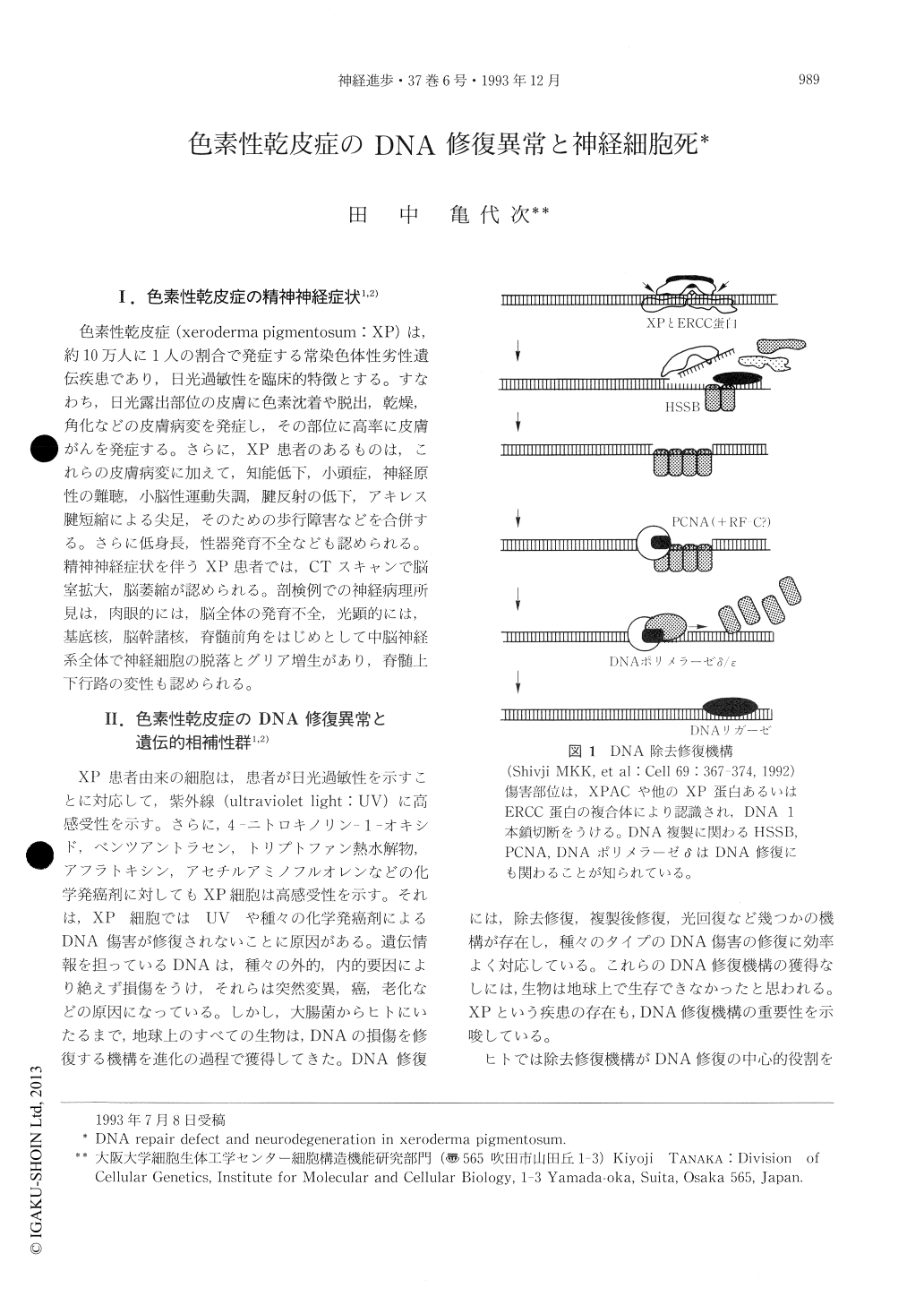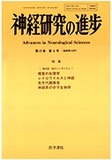Japanese
English
- 有料閲覧
- Abstract 文献概要
- 1ページ目 Look Inside
I.色素性乾皮症の精神神経症状1,2)
色素性乾皮症(xeroderma pigmentosum:XP)は,約10万人に1人の割合で発症する常染色体性劣性遺伝疾患であり,日光過敏性を臨床的特徴とする。すなわち,日光露出部位の皮膚に色素沈着や脱出,乾燥,角化などの皮膚病変を発症し,その部位に高率に皮膚がんを発症する。さらに,XP愚者のあるものは,これらの皮膚病変に加えて,知能低下,小頭症,神経原性の難聴,小脳性運動失調,腱反射の低下,アキレス腱短縮による尖足,そのための歩行障害などを合併する。さらに低身長,性器発育不全なども認められる。精神神経症状を伴うXP患者では,CTスキャンで脳室拡大,脳萎縮が認められる。剖検例での神経病理所見は,肉眼的には,脳全体の発育不全,光顕的には,基底核,脳幹諸核,脊髄前角をはじめとして中脳神経系全体で神経細胞の脱落とグリア増生があり,脊髄上下行路の変性も認められる。
Xeroderma pigmentosum (XP) is an autosomal recessive disease, clinically characterized by a high incidence of sunlight-induced skin cancer and neurological complications. Cells from XP patients are hypersensitive to killing by ultraviolet (UV) radiation because of a defect in nucleotide excision repair. There are eight genetic complementation groups of XP, group A-G and a variant. Group B XP and some of groups D and G XP patients also show Cockayne's syndrome (CS). Group A and C XP genes (XPAC and XPCC genes) have been directly cloned by transfecting and correcting each group of XP cells with mouse genomic DNA and human cDNA library, respectively. On the other hand, many rodent nucleotide excision repair mutants have been generated and at least 11 complementation groups have been identified. By the same transfection-correction cloning strategies using these rodent mutants as recipi-ents, a series of complementing human nucleotide excision repair genes has been retrieved. These were designated ERCC (excision repair cross complementing rodent repair deficiency) genes. Some of the rodent complementation groups have proven to be equivalent to XP or CS complementation groups with group 2 equivalent to XP-D, group 3 to XP-B, group 5 to XP-G, and group 6 to CS-B. That is, the ERCC2, 3, 5 and 6 genes are equivalent to XPDC, XPBC, XPGC and CSBC genes, respectively. The nucleotide excision repair process is evolutionarily conserved in eukaryotes, and homologs of the XP and ERCC genes have been identified in S. cerevisiae and D. melanogater. The XPAC protein is a damage-recognition protein. The loss of function of the XPAC protein caused severe defect of nucleotide excision repair. The neurological abnormalities in group A XP may be caused by the defect of nucleotide excision repair of DNA damaged by dietary or endogeneously produced agents in neurons. The ERCC2, 3, and 6 genes have consensus amino acid sequences for helicase. The RAD3, a yeast homolog of ERCC2, was proven to have helicase activities. Recently, XPBC/ERCC3 protein was identified as part of the basal transcription factor TFIIH. XPBC/ERCC3 protein may carry out DNA unwinding for loading the transcription complex and the repair complex on DNA. The eukaryotic nucleotide excision repair system may recruit many of its factors from proteins already involved in other basic aspects of DNA and RNA metabolisms such as replication, cell cycle, recombination and transcription. The neurological abnormalities in XP-B/CS may be generated by the developmental abnormalities of the CNS due to transcription deficiency. The drosophila mutant haywire was found to have a defect in the ERCC3/ XPBC gene homolog. The mutant showed developmental abnormalities in the CNS. This observation supports the above idea. In this sense, XP-B/CS may be termed transcription syndrome.

Copyright © 1993, Igaku-Shoin Ltd. All rights reserved.


